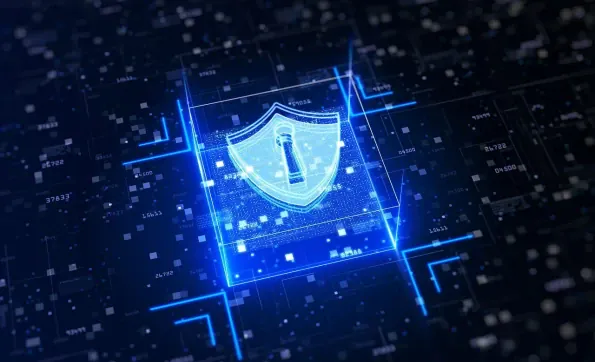Only four months in, and 2025 has already experienced a meteoric rise in business security threat sophistication—ranging from devastating deepfake deceptions to telephonic communication interceptions. Overcoming these obstacles demands that organizations reevaluate their security strategies, as cybercriminals quickly catch on to the advanced technologies powering modern business operations—and subsequently use it against them.
As the year unfolds, staying ahead of the cybersecurity curve is no longer optional, but mission-critical. In this article, you will dive deep into the key trends to keep an eye on as security teams traverse the ever-evolving threat landscape—zoning in on innovative security solutions and strategies that ease the process of safeguarding systems.
AI vs AI: A Modern Cybersecurity Arms Race
From continuous learning to massive problem-solving capabilities, artificial intelligence (AI) is pulsing waves of change throughout the business world. With features advancing more and more by the day, AI has the power to process and analyze the vast amounts of data that are generated during modern operations. By filling in the gaps left by traditional security measures, AI brings forward an unparalleled approach to identifying unexpected system variations and potential operational threats.
AI-Driven Cyberattacks
However, protections against such malicious activity have simultaneously opened the door wide open for cybercriminals to creep in—armed to the teeth by AI itself. Today’s cyber threat actors are employing the very same technology that builds businesses up to consequently tear them down. This is done through the development of highly sophisticated attack vectors, like phishing and malware, whereby threat actors automate and scale nefarious activity through dynamic attack models—which are becoming increasingly difficult to detect.
Distributed Denial-of-Service and Telephone Denial-of-Service Threats:
For example, Distributed Denial-of-Service attacks congest networks, rendering them inaccessible to both legitimate and potential website users. By utilizing AI, threat actors now also have the power to intercept voice-calling operations.
For industries where communication is mission-critical, like healthcare and finance, Telephone Denial-of-Service disrupts phone systems by bombarding them with robotic calls—making authentic communications impossible.
Deepfakes
Another ever-evolving AI-based threat that is troubling enterprises worldwide is the proliferation of deepfake frauds. By synthetically modifying media by impersonating real people, deepfake technology is blurring the lines of reality through the digital manipulation of video, photos, and audio.
Often, these attempts aim to disseminate false information and deceive users for financial gain. In 2020, threat actors made an audio deepfake to steal from a Hong Kong financial institution and siphon $35 million—the largest publicly disclosed value lost to inauthentic content.
AI for Cyber Defense
The increasing complications of these cyber threats lie in their highly undetectable nature. To say that traditional security measures are no longer sufficient would be an understatement. While it may seem counterintuitive, the best path forward is to fight fire with fire by defending AI-based attacks through artificial intelligence itself.
The question is: what can organizations do to ensure their AI cybersecurity posture is resilient enough to stand strong against their criminal counterparts?
Threat Detection and Response:
Many modern enterprises leverage artificial intelligence to accelerate the identification and response to system anomalies and compromising indicators in real time. Upon detection, AI-powered cybersecurity solutions automate incident response protocols—such as isolating infected infrastructure or redirecting traffic—to cease potential damage and decrease recovery costs. Additionally, integrating machine learning capabilities enables companies to evaluate historical attack data to readily recognize new and emerging threats.
Risk Assessment and Predictive Security:
To forecast cyber hazards before they disrupt operations, AI-driven predictive protection pinpoints system vulnerabilities before setting off proactive risk alerts. This approach also enables more resilient risk assessment through automated scoring, whereby AI allocates risk levels to varying data assets based on real-time analytics. This, in turn, empowers the establishment of dynamic security policies and regulatory compliance optimization to redirect cybersecurity efforts toward a company’s most critical risks.
Zero Trust: The New Security Standard
As cyber threats continue to multiply, more organizations are quickly moving away from perimeter-based protection and toward Zero Trust Architectures. This modern security framework negates implicit trust while driving continuous verification for all access requests and addresses potential compromises originating from internal and external sources. Companies, like Phoenix Cyber, help other enterprises to secure their operations and identities by providing robust automation, orchestration, and analytical capabilities through Zero Trust Architecture solutions.
Zero Trust Architecture
There are six principles that form the foundation for Zero Trust Architecture success, some of which include:
Endpoint Security: Strengthening this approach requires all endpoints to be soundly secured prior to granting network access. Such security measures include leveraging specialized software, like endpoint detection and response tools to drive reliable system health checks.
Least Privilege Access: When it comes to providing access to users and devices, this architecture ensures that it is granted at the minimum level necessary to complete a task. It’s essential that access completely considers the context of requests, such as why or when a request is issued.
Identity Verification: From users to devices, continuous identity verification occurs at every level of every interaction through stringent authentication protocols, like multi-factor authentication.
More Than Multi-Factor Authentication:
To take identity verification one step further, enterprises leverage advanced techniques and technologies that exceed multi-factor authentication capabilities. Biometric authentication, like vocal and facial recognition, takes into account individuals’ unique physical attributes to confirm identities.
By doing so, security teams can ensure higher levels of protection and accuracy—rendering it difficult for threat actors to imitate users. Similarly, behavioral biometrics rely on distinctive characteristics associated with how a person interacts with applications, like mouse movements and typing patterns.
Network Segmentation:
The accelerated adoption of hybrid workforces and multicloud environments necessitates businesses to jump on the Zero Trust Architecture bandwagon as attackers are exploiting lateral movement to tear down traditional, well-defined perimeters. To squash these threat actors, organizations need to build a Zero Trust Architecture combined with holistic network segmentation.
This approach makes it so that security teams can confidently minimize the attack surface by containing damage to just one zone, while sparing the rest. Additionally, each segment is equipped with its own security policies and network controls to bolster visibility.
Conclusion
From the accelerated adoption of artificial intelligence and machine learning to the proliferation of Zero Trust Architectures, the modern business security landscape is transforming to confidently combat the inundation of today’s malicious threats. However, these trends can become a double-edged sword when found in the wrong hands—with attackers using the very same advanced technology to initiate deceptive imitations and AI-powered disruptions.
It is evident that legacy security approaches are inadequate against these compromises. Companies need to double down on the power of their own AI-driven defenses to detect anomalies in real time, automate threat responses, and proactively predict vulnerabilities. The current state of cybersecurity demands immediate action to stay one step ahead of the perils of the digitally diverse business world. The future of security is here—and it’s game-changing.




